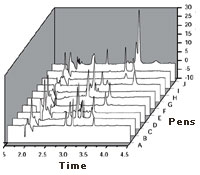HOIST
ON YOUR OWN BALLPOINT PEN
A Matter of Ink Evidence
07/05/05
 Evidence from handwritten
notes has been a hallmark of crime detection for a long time--but forensic
technology has just made the process that much more sophisticated.
Evidence from handwritten
notes has been a hallmark of crime detection for a long time--but forensic
technology has just made the process that much more sophisticated.
That's good
news for investigators of insurance fraud, currency counterfeiting,
tax evasion, and insider trading violations. Just consider
a recent case involving the ink of a particular entry on a stock worksheet
that was tested against the rest of the document's ink. Differences
in the samples suggested that the questioned entry was made on a separate
occasion, possibly to cover insider trading violations.
In their articles
in this month's Forensic
Science Communications, FBI research chemists James Egan, Jason Brewer,
and Kristin Hagan demonstrate advances in the forensic analysis of ballpoint
pen inks--both for black inks and blue inks.
Why different articles
on different colors? Black and blue inks contain dye formulations that
have different properties, which requires different methods to separate
the dye components.
What's the
usual way? A process called thin-layer chromatography (TLC)
is normally used. An ink sample is spotted on a silica-gel slide and
separated into its components by a solvent system. The spots can then
be visualized under visible or ultra-violet light then compared to
a reference library (e.g. the Secret Service's TLC library consists
of ~8,500 inks). It's an important technique, however the process can't
be automated. In addition, the TLC plates should be stored in a controlled
environment and no spectroscopic data is obtained.
What's an
alternative approach? Capillary electrophoresis (CE) has recently
been used for ink analysis. A minute volume of ink (nanoliters) is
injected in a narrow silica capillary filled with a buffer solution.
Electrical current is then applied to the capillary to separate the
ink into its components. Each component passes a photodiode array detector,
which records an ultraviolet-visible spectrum. The process is automated,
fast, and results can be stored electronically allowing the development
of a searchable reference library. This process also detects non-dye
additives in the ink that potentially can be used as identifiers.
Do you speak
chemistry? It helps to be a chemist when you're reading these
articles. We started to bog down when we read Figure 5 in the Black
Ink article... "shows the presence of two dye peaks that are close
in µep values and have spectral similarities greater than 90
percent for Crystal Violet and Rhodamine Base B. The first dye peak
(tm = 3.40 min, µep = –1.08 x 10–4 cm2V–1sec–1)
agrees well with the µep and ultraviolet-visible spectrum of
Rhodamine Base B, whereas the second peak (tm = 3.99 min, µep
= –1.41 x 10–4 cm2V–1sec–1) agrees with the µep
and spectrum of Crystal Violet."
But everyone can appreciate
the results and the possibilities for future applications. And what might
these be? "Initial experiments suggest that the combination of the
anionic and cationic dye capillary electrophoresis methods can be applied
to food dyes, textile dyes, and ink-jet dyes."
Link: Laboratory
Services


